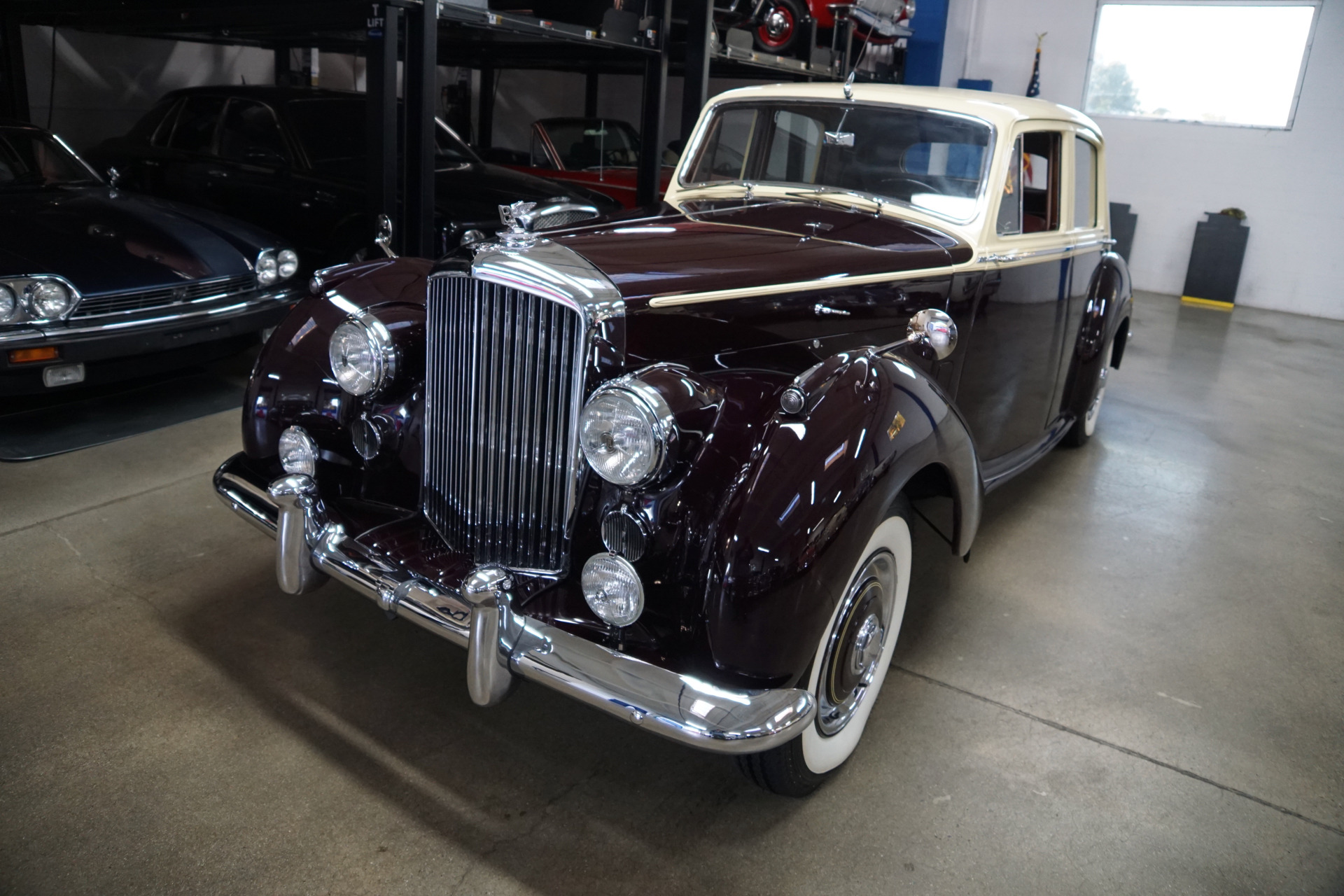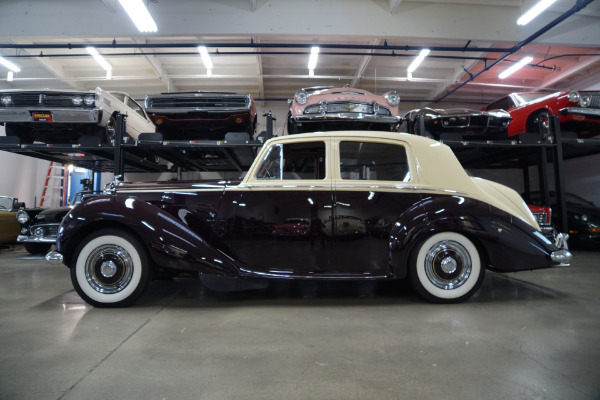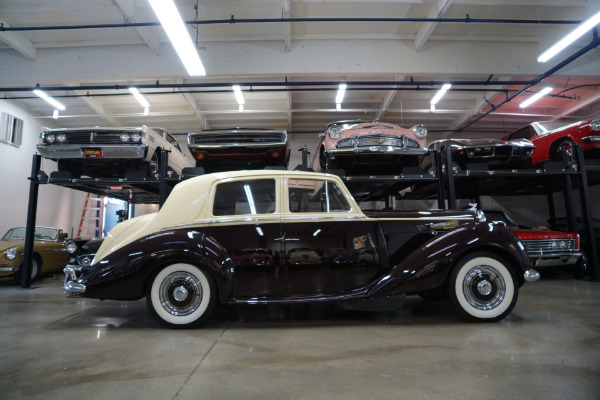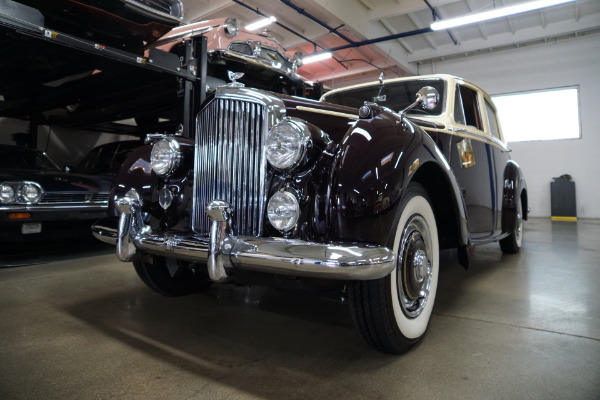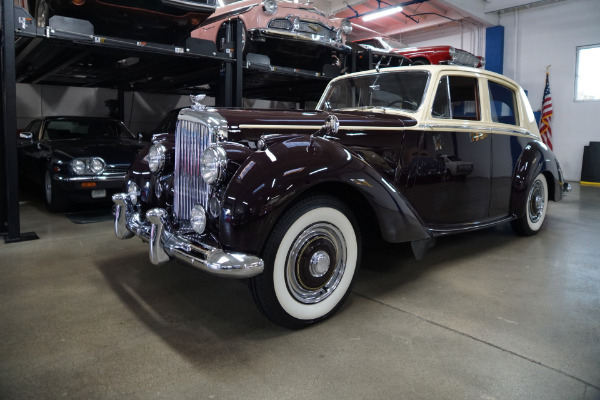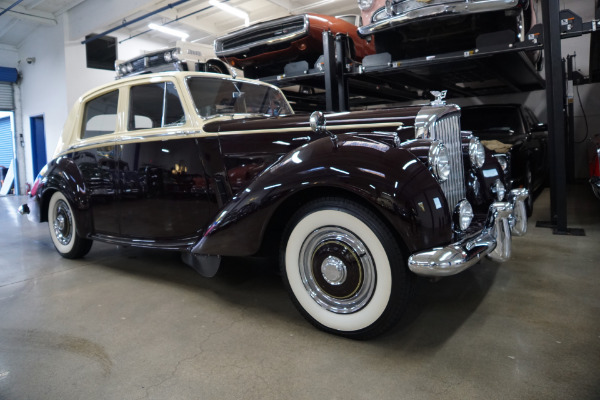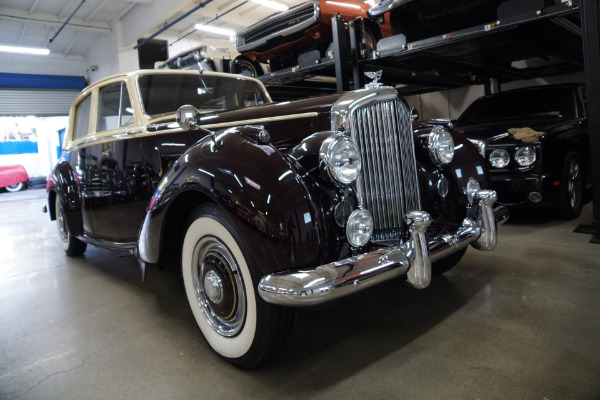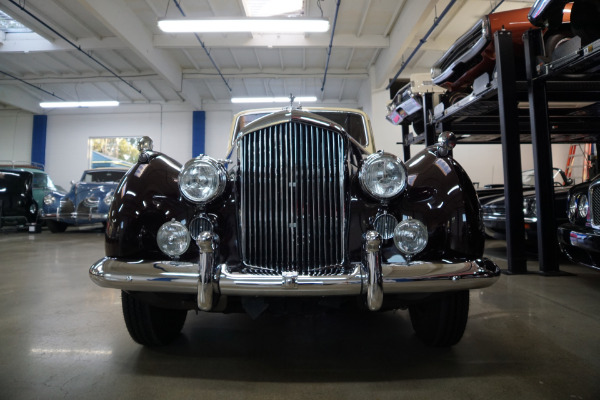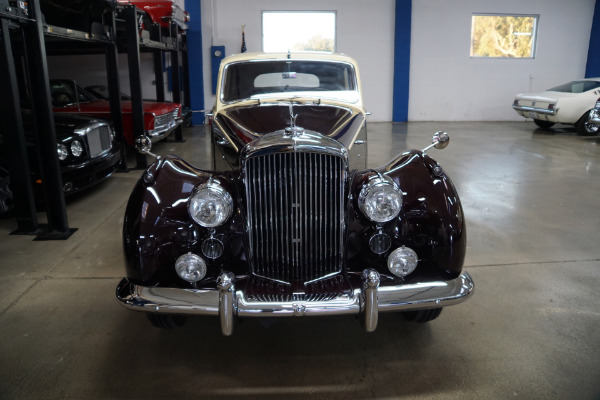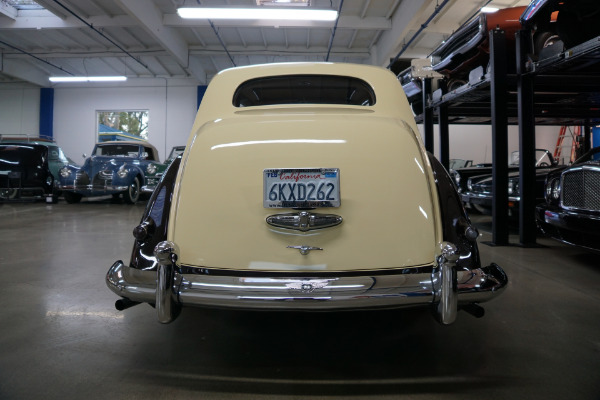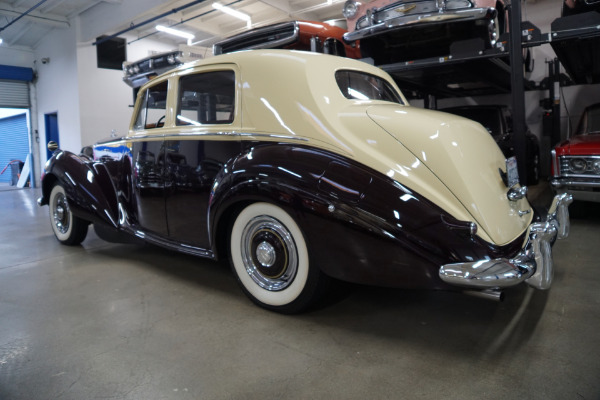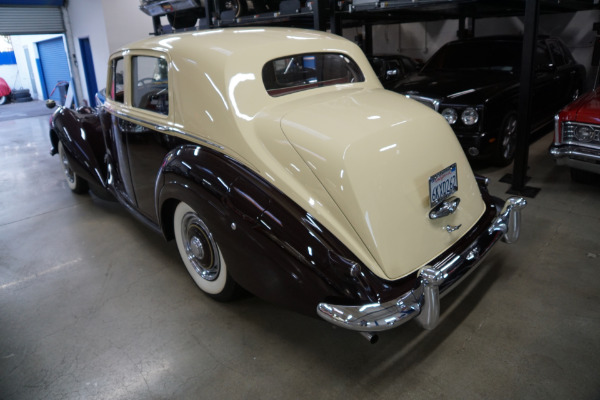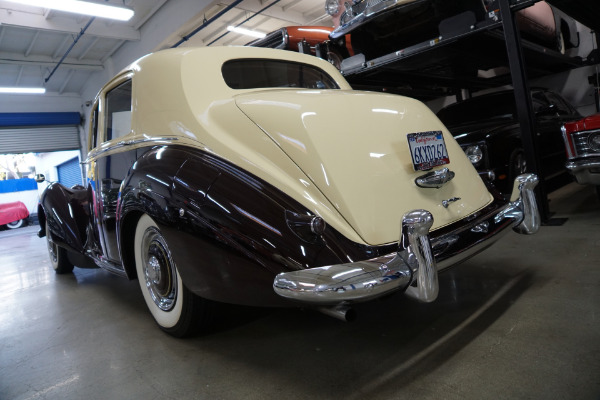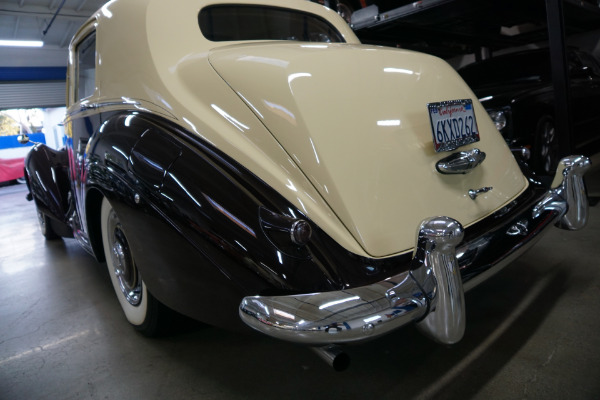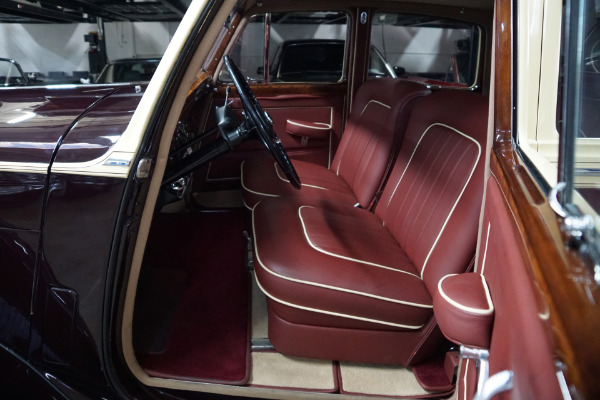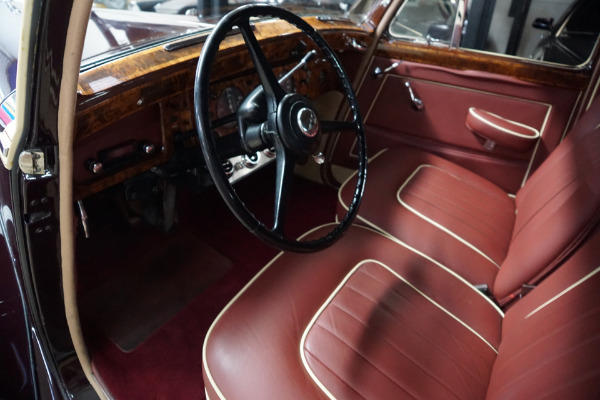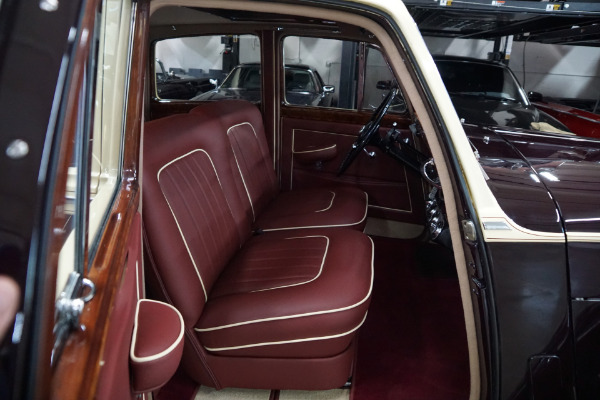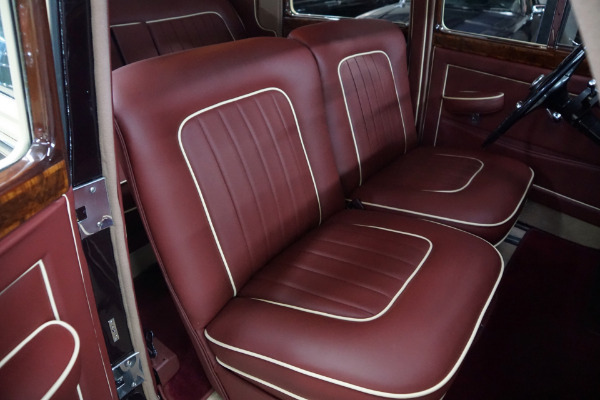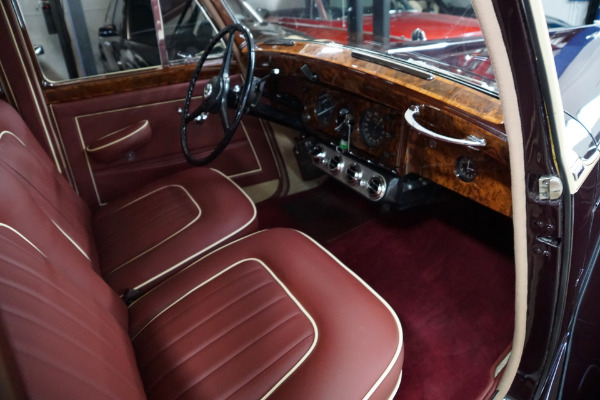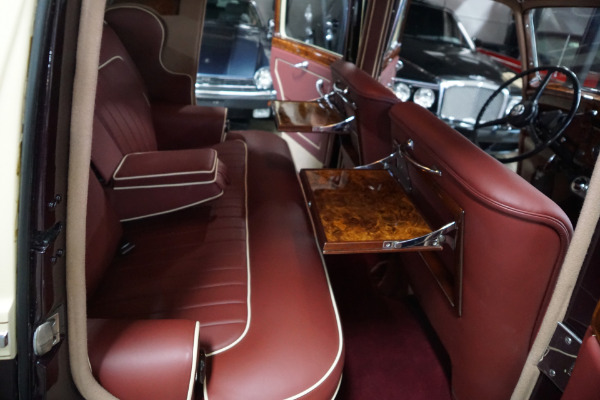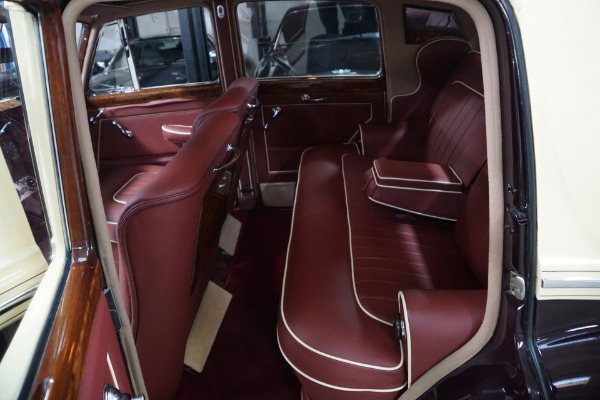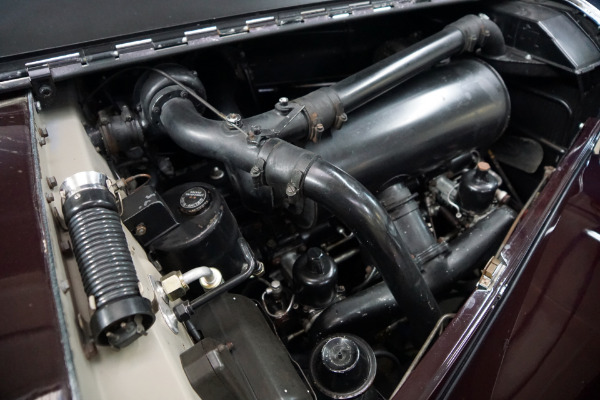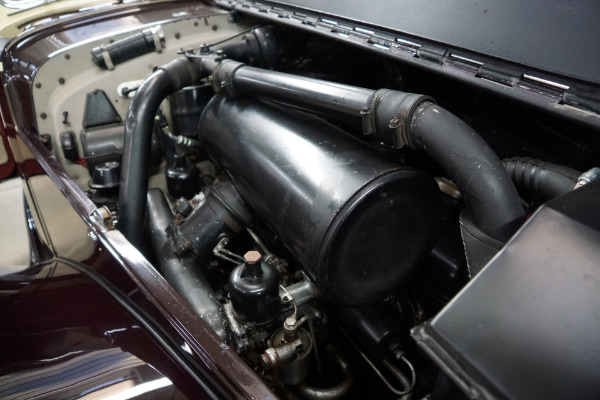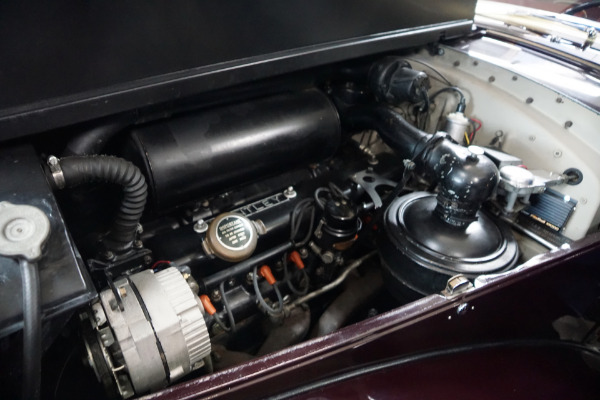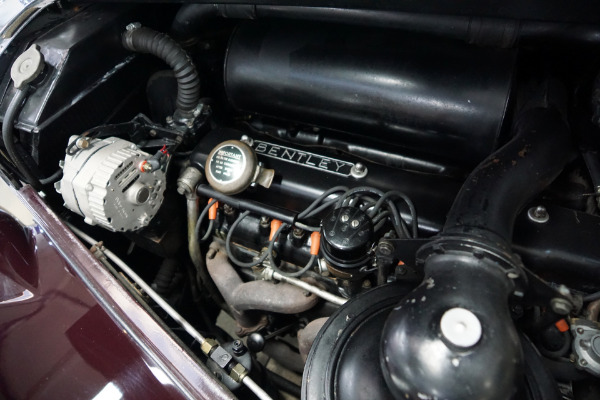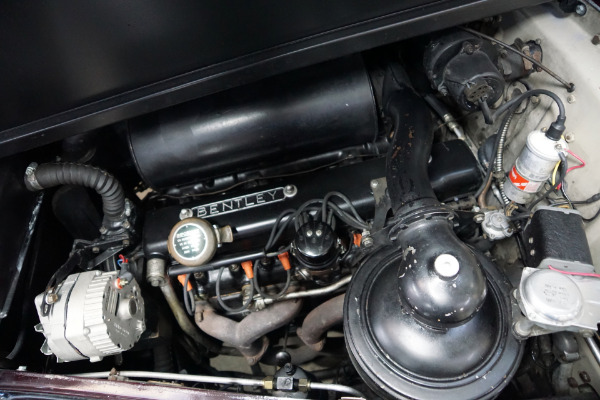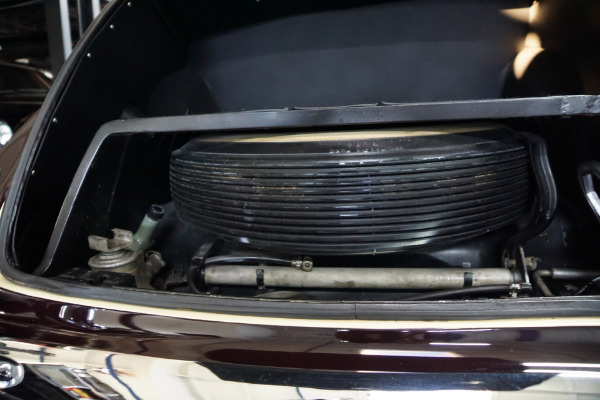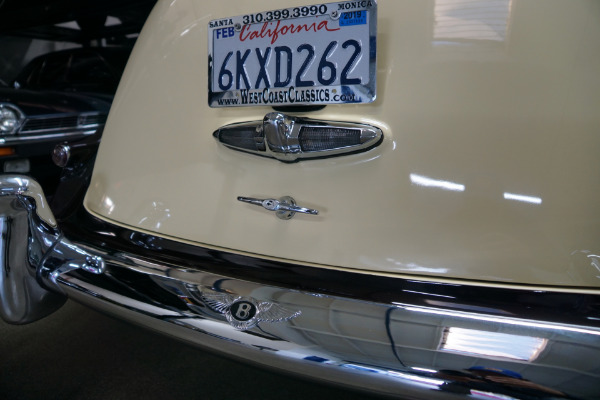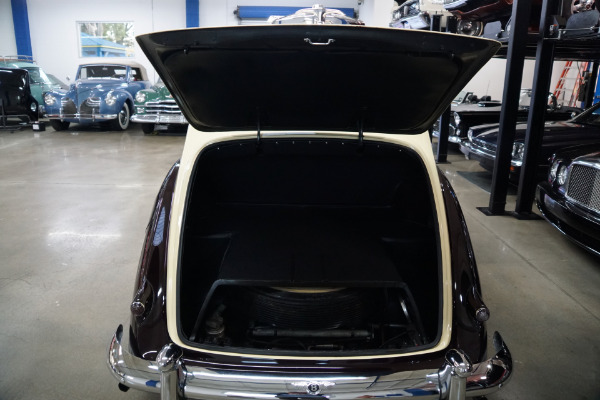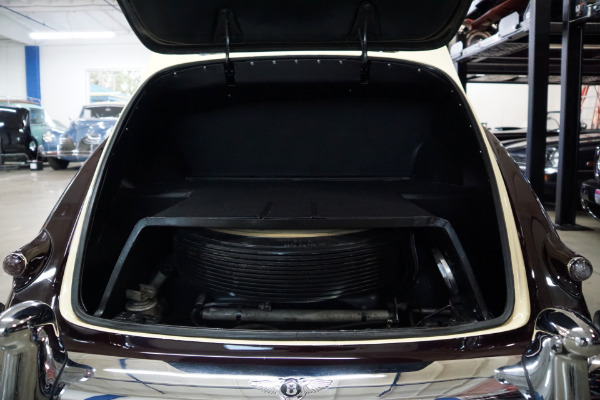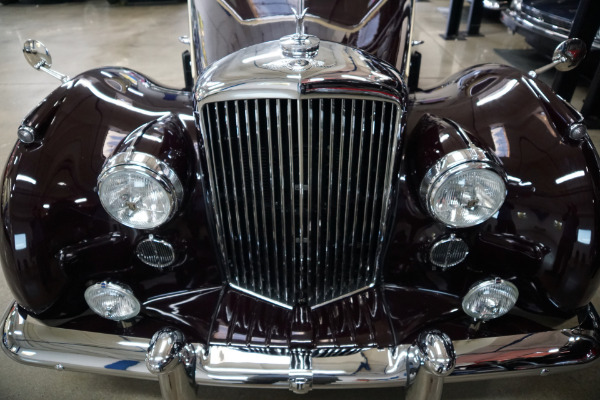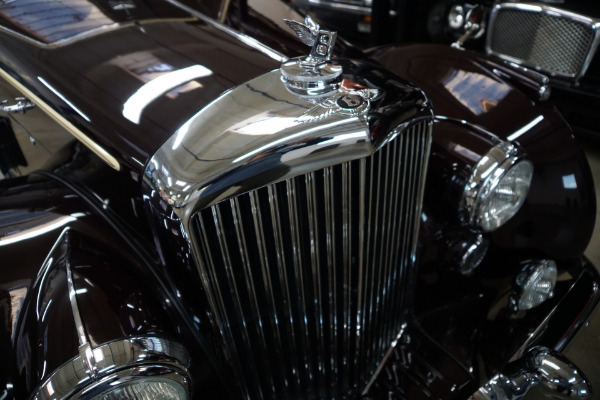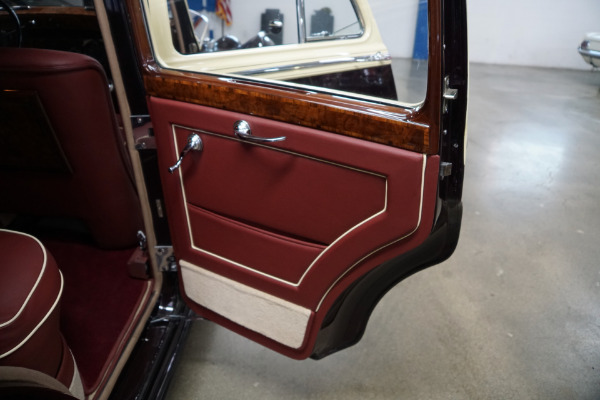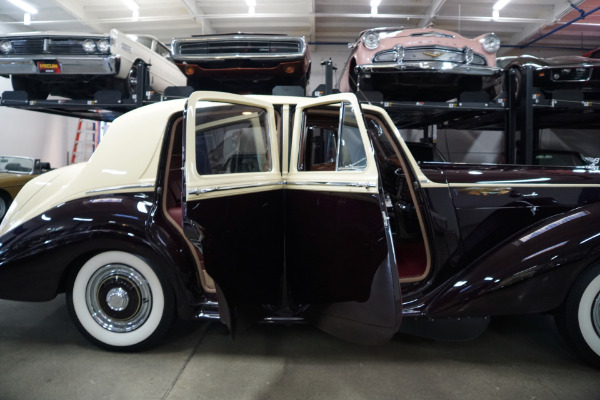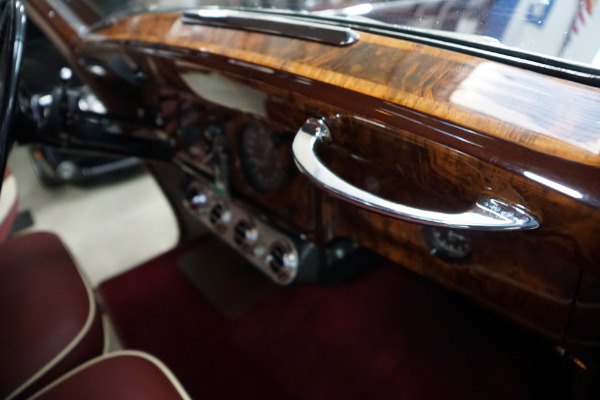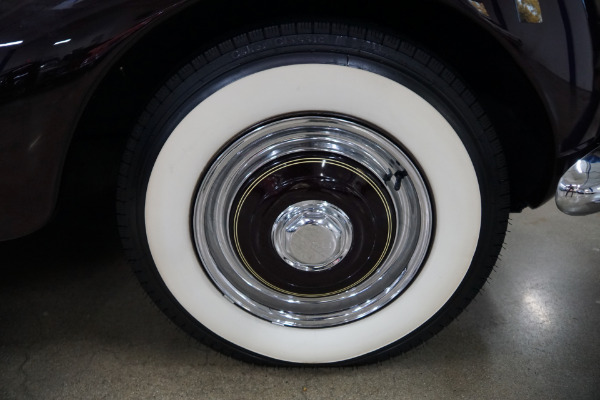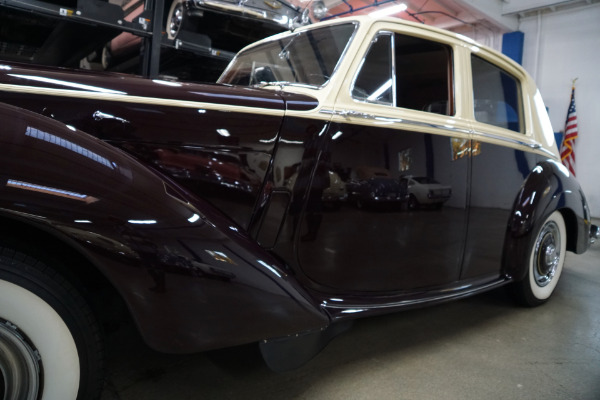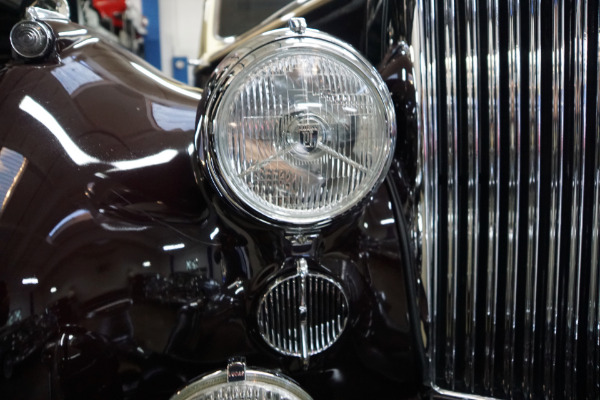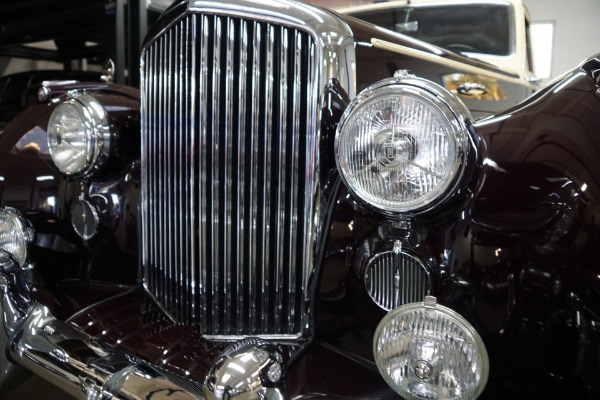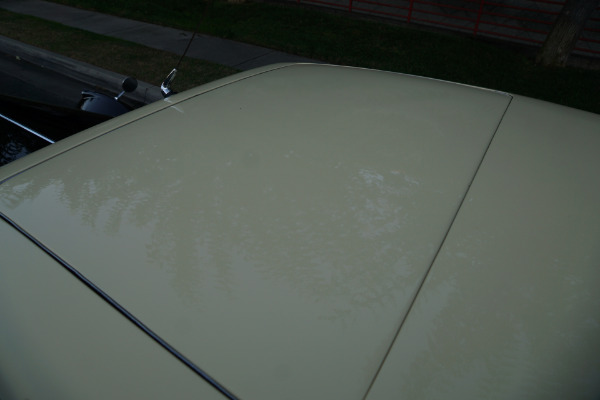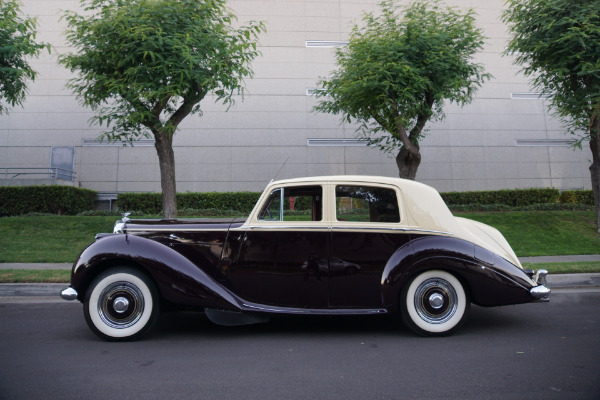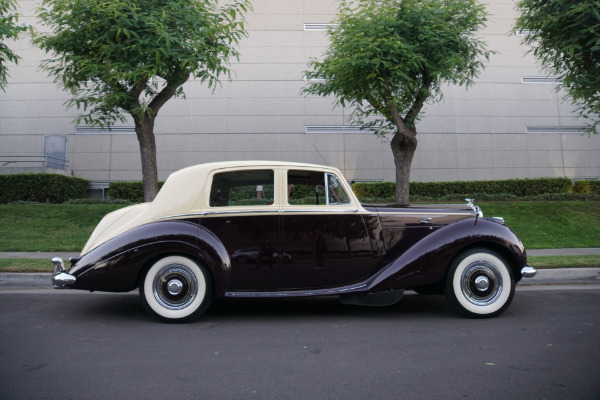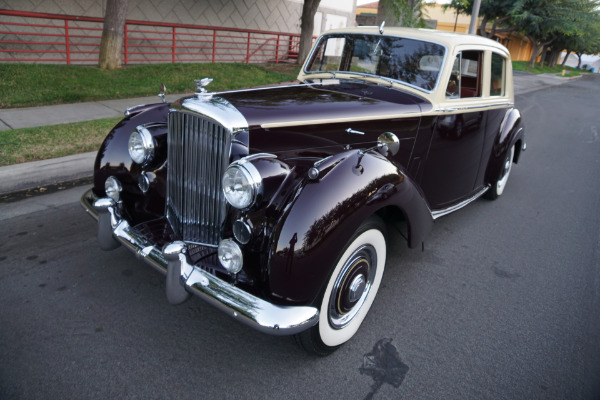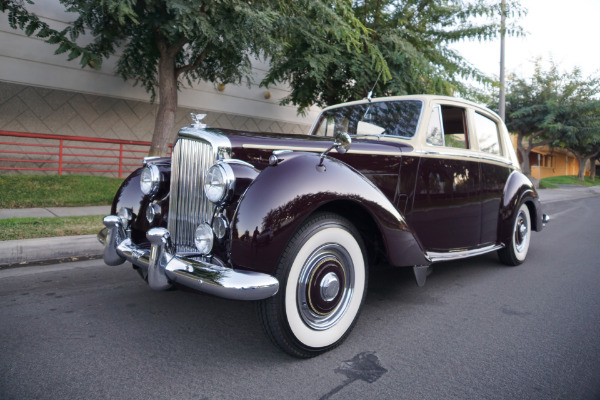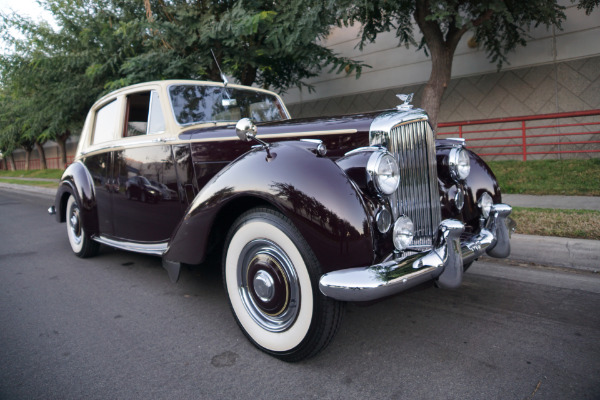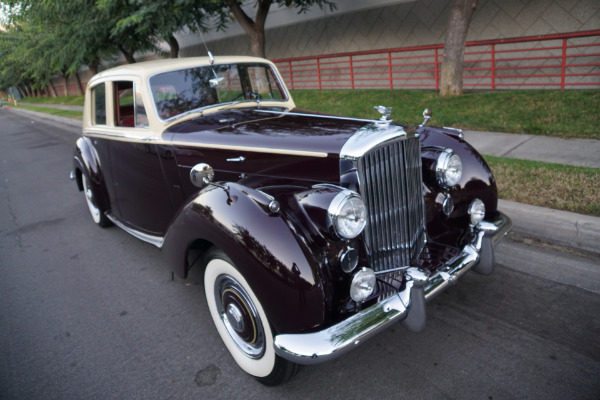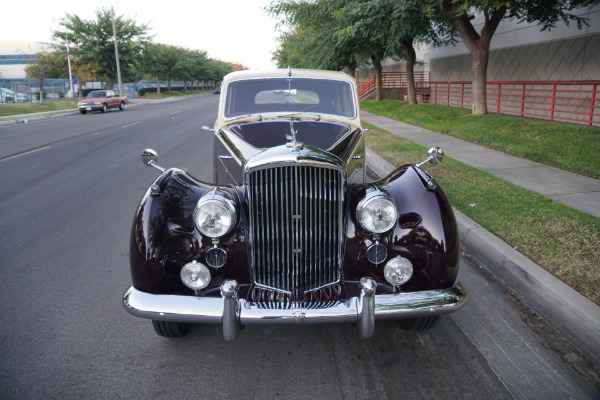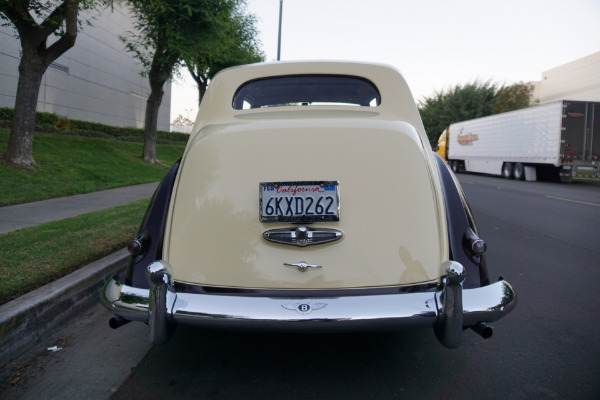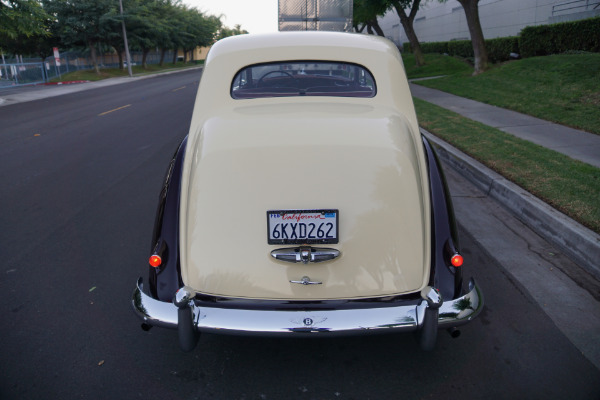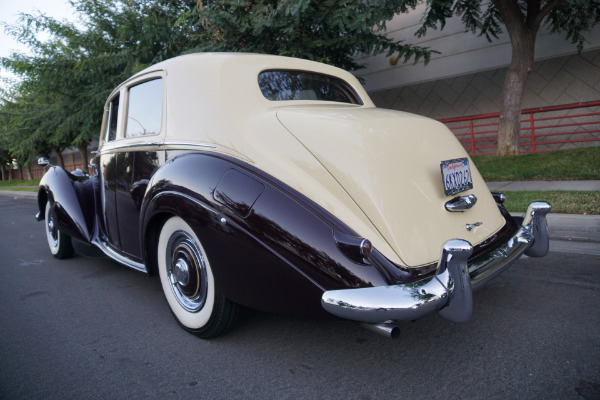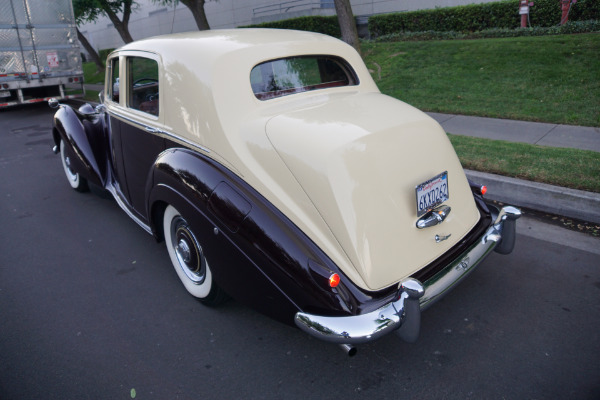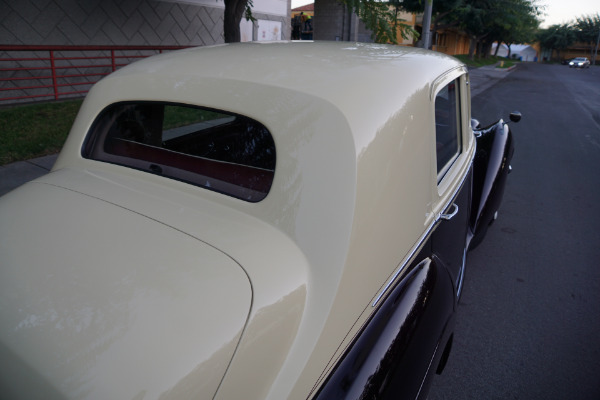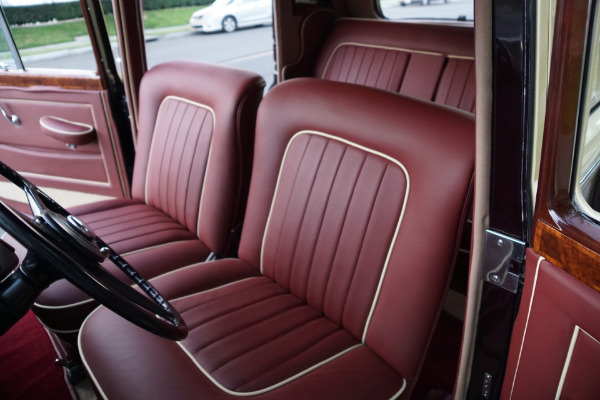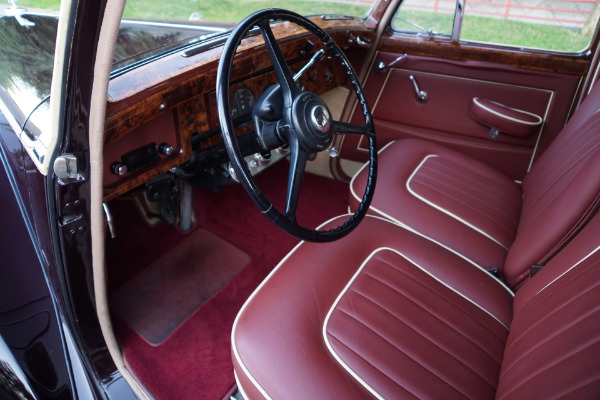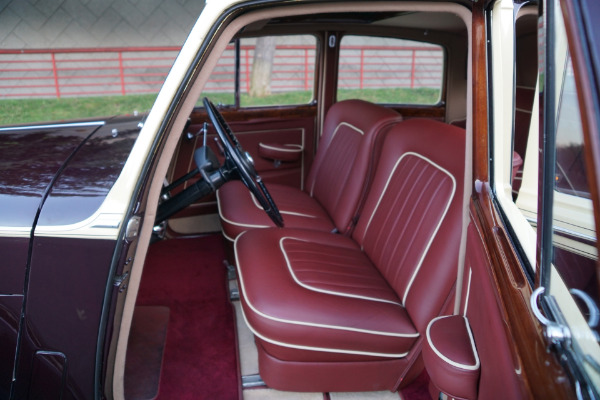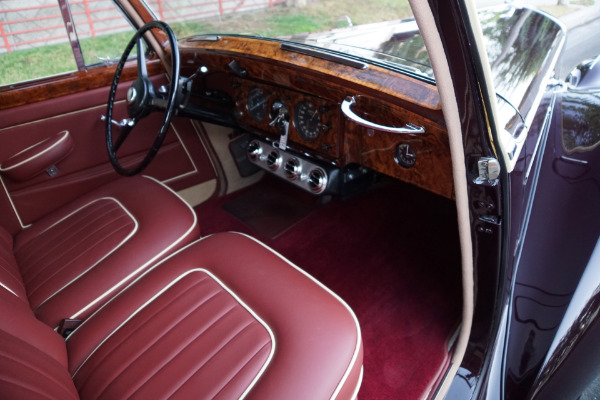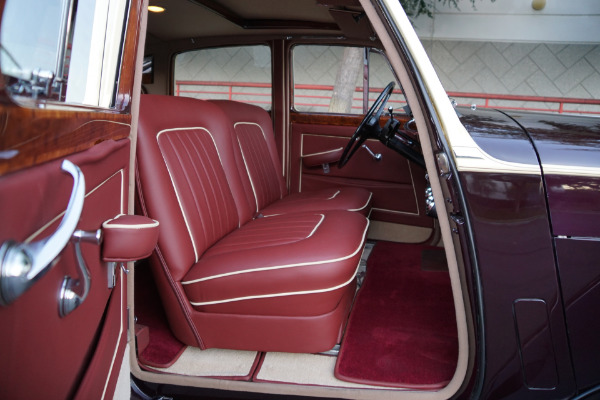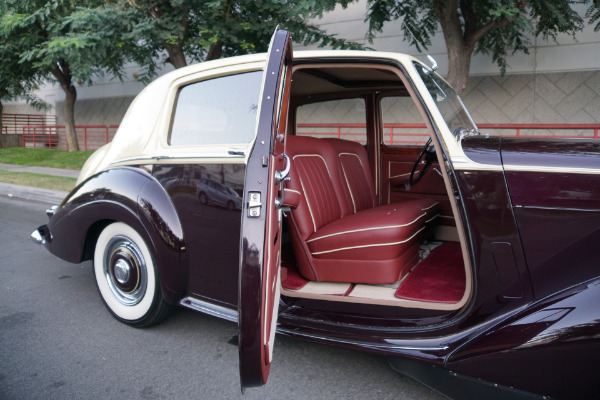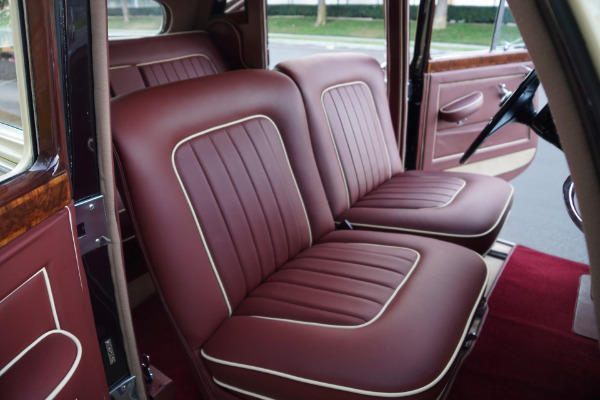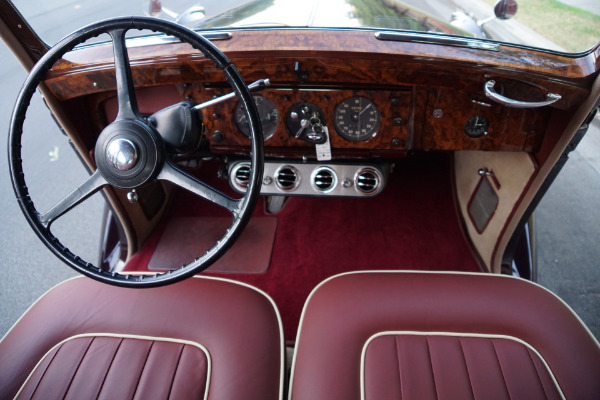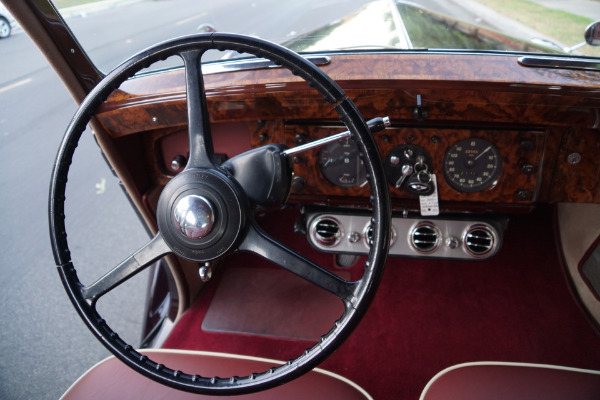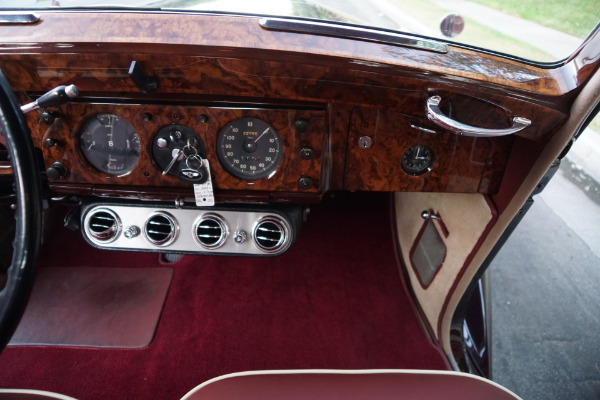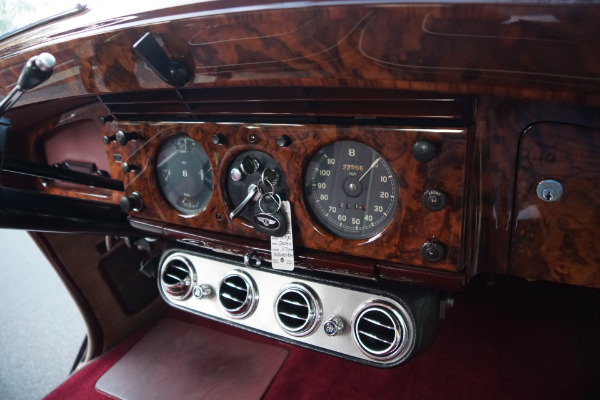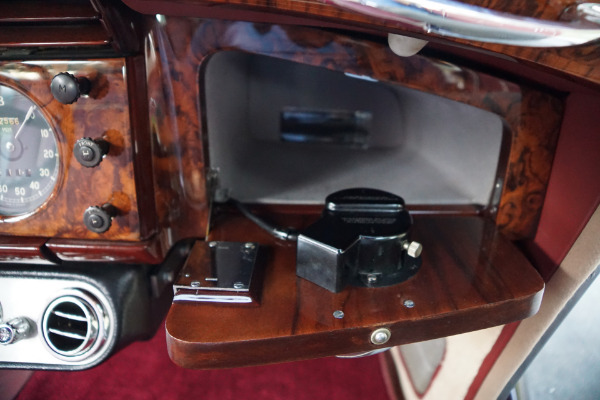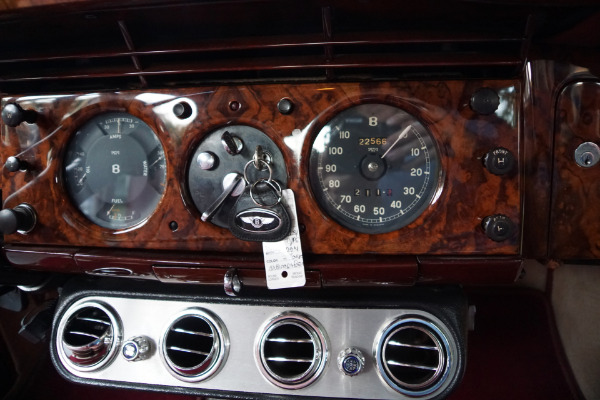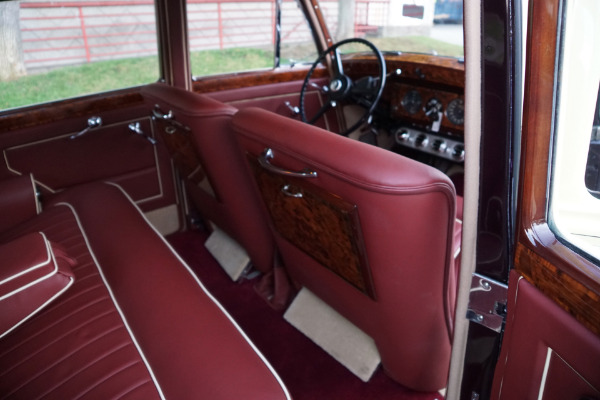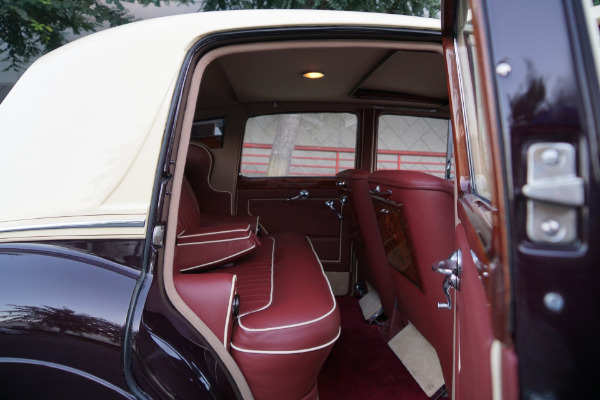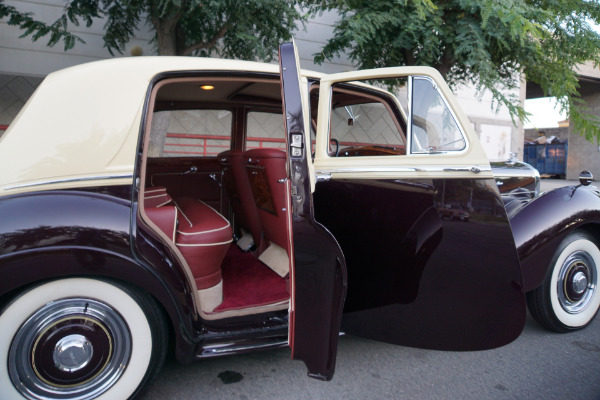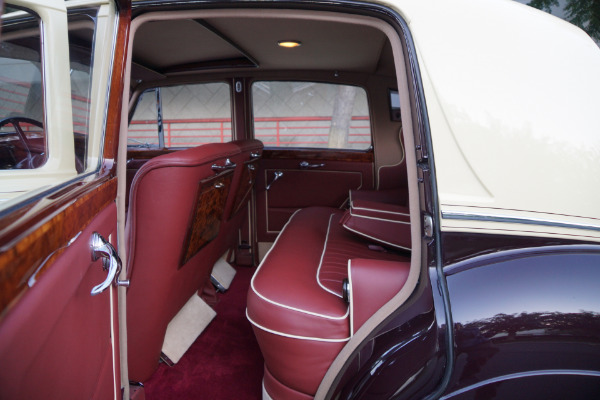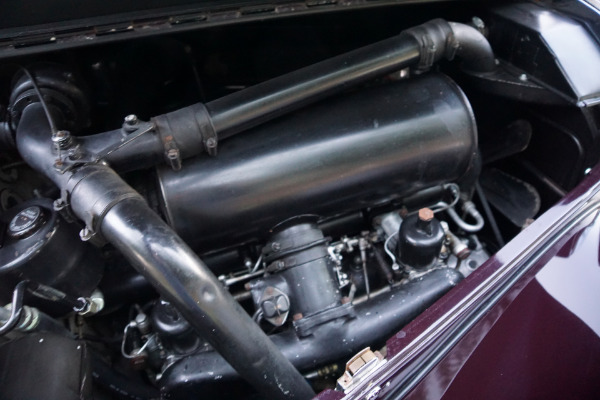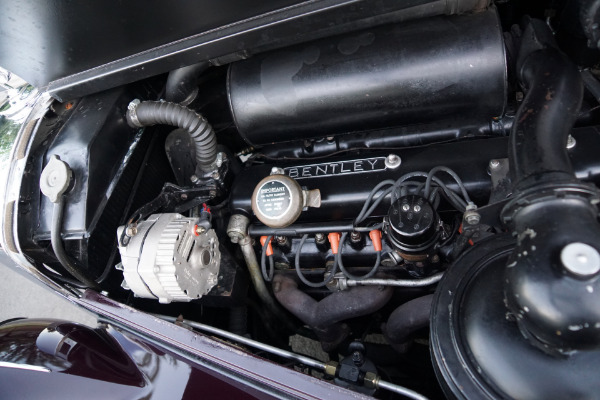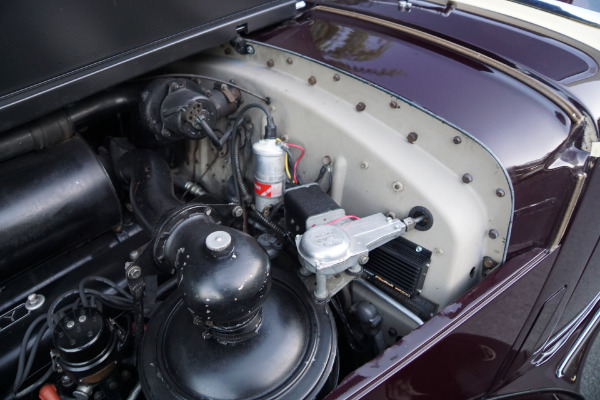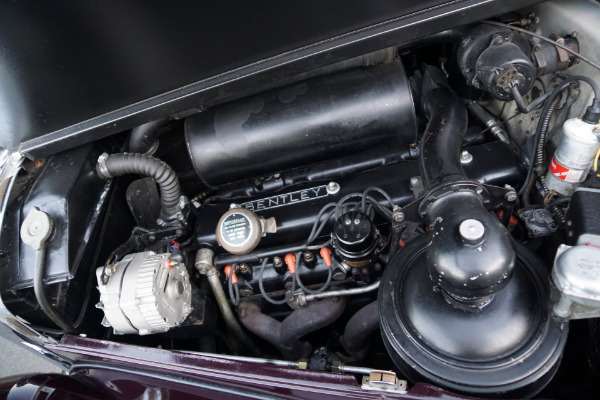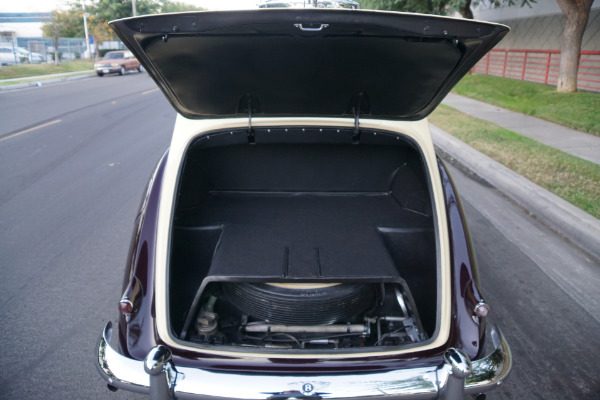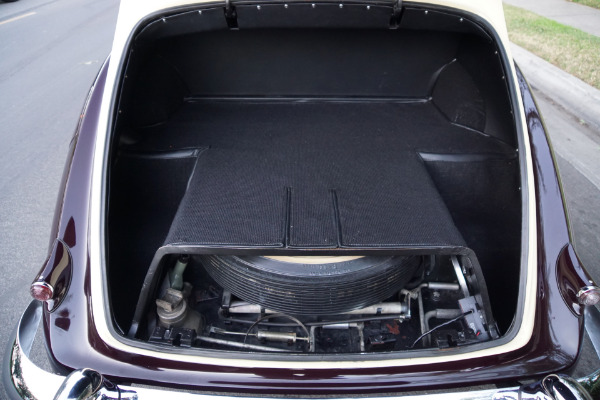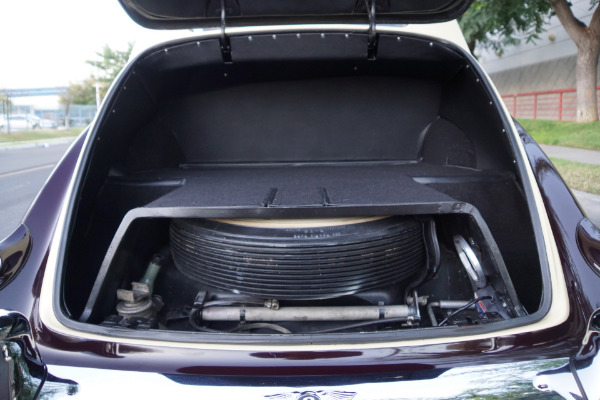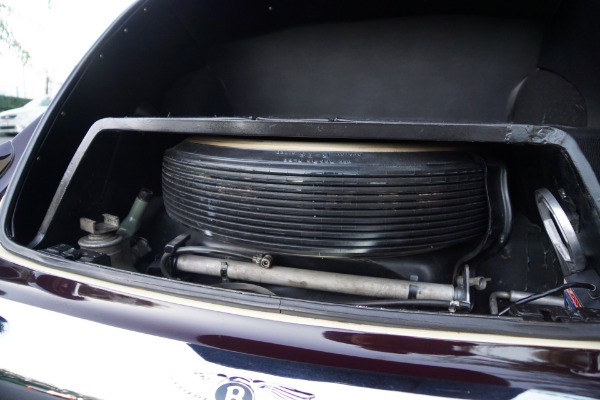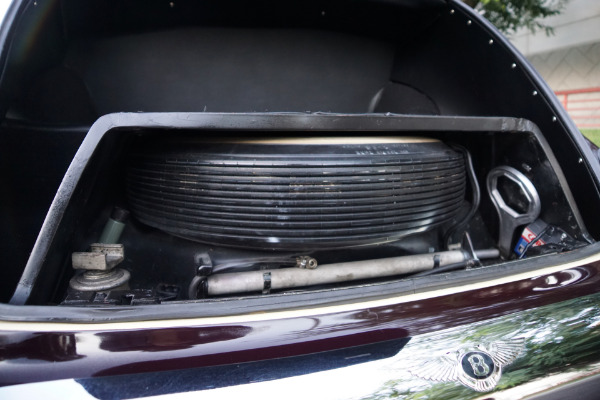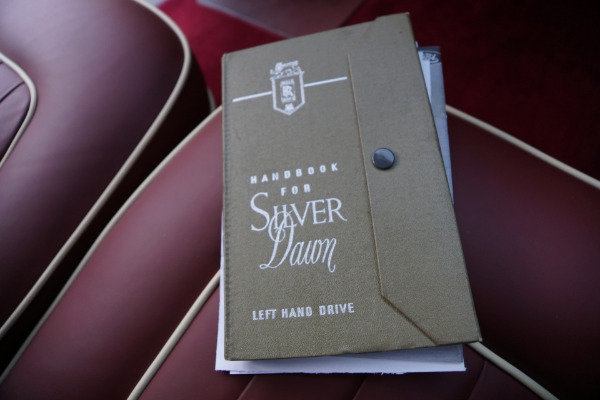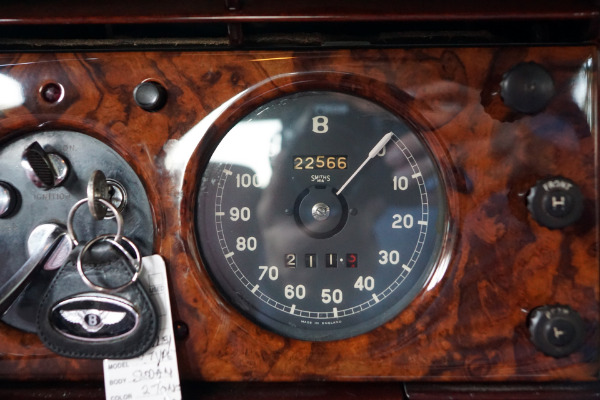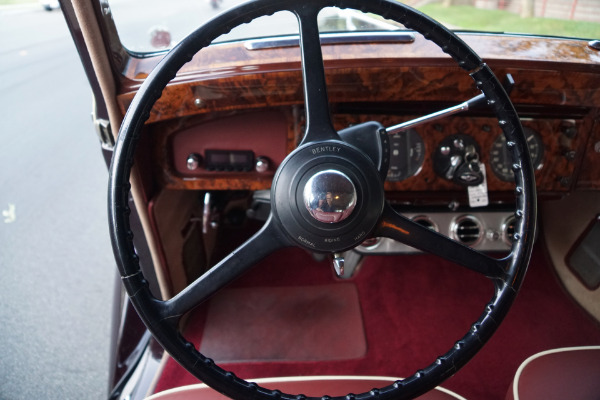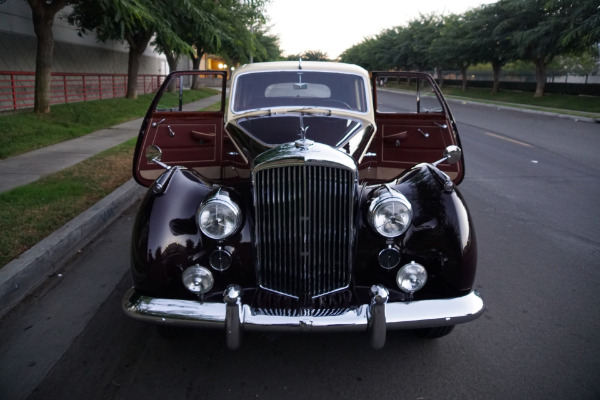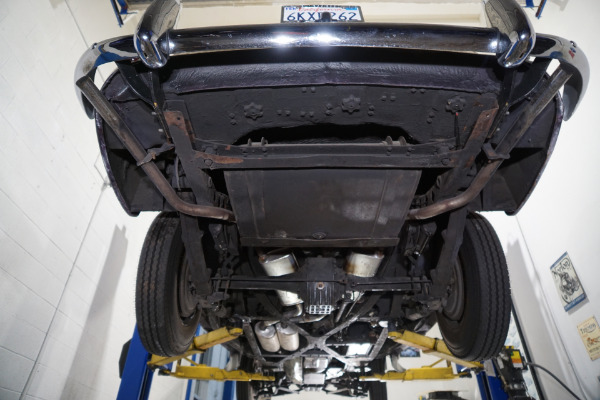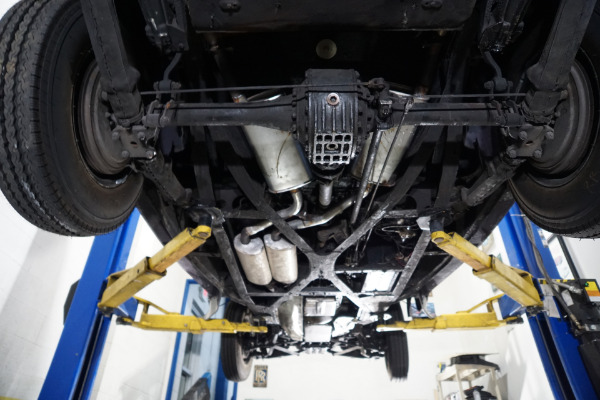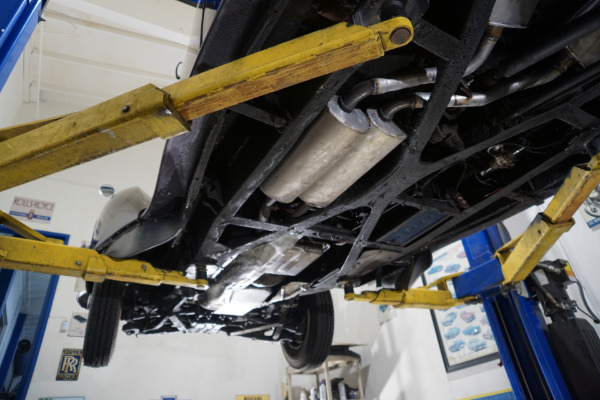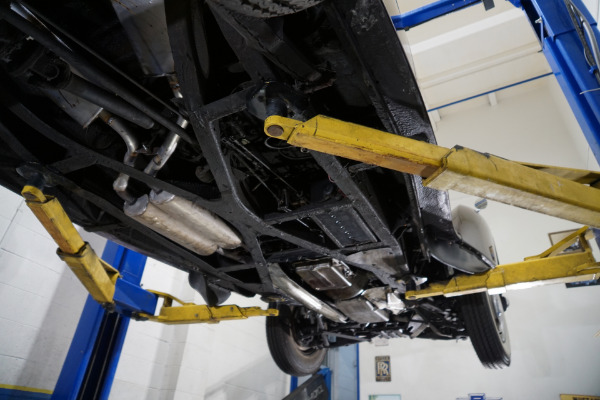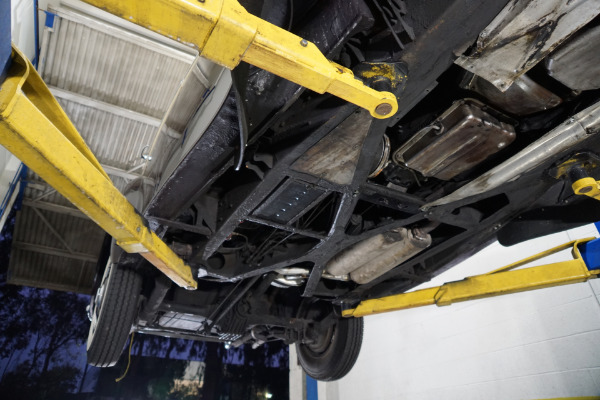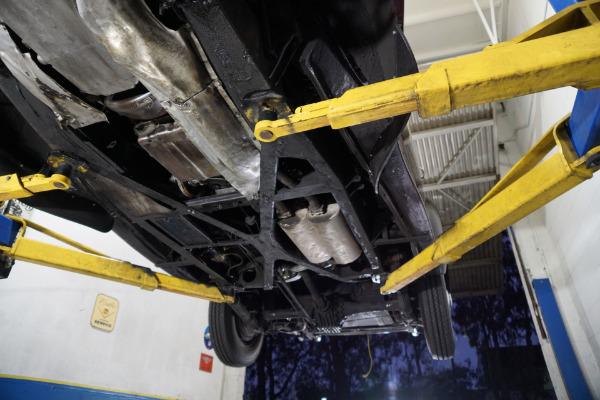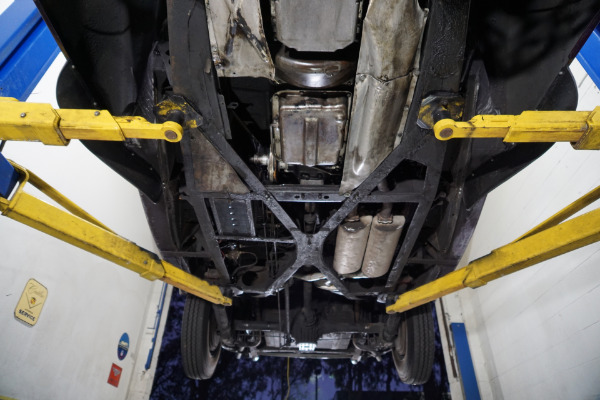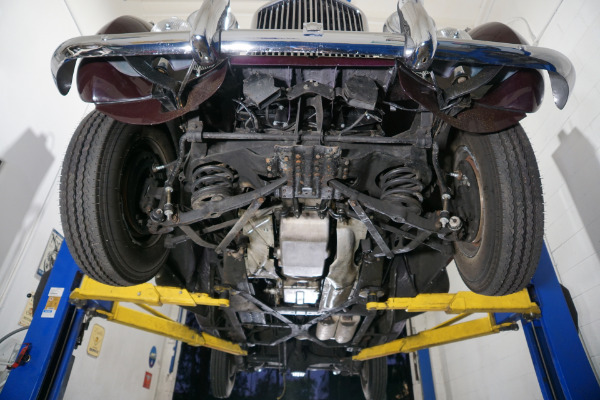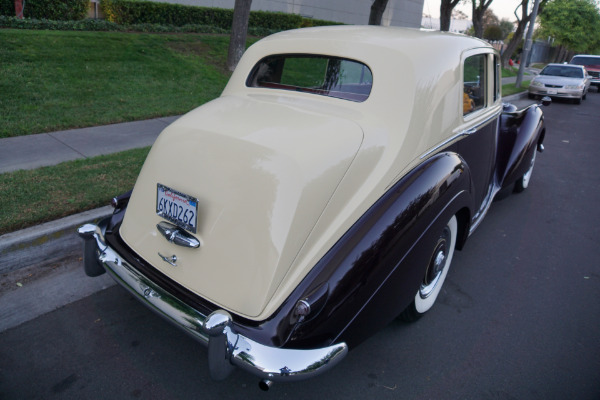West Coast Classics are proud to present a very rare and absolutely exceptional and exquisite example of this 1953 Bentley R-Type 4 Door LHD 4 1/2 litre 'Big Bore' sedan with factory optional 4 speed automatic transmission and 1 of only some 2,323 built in it's three year production run between 1952-55 and a very rare Left Hand drive example with air conditioning.
This particular example is strikingly finished in a 'Royal Garnet over Cream' two-tone color complete with hand painted pin stripes which is matched to a beautiful and also extraordinarily condition full 'Claret with White Piping' leather interior and carpeting. The car has an original Mohair headliner and it's original factory sliding sunroof. This car was frame up restored with no expense spared in recent years and has been stored in a climate controlled facility by it's southern California collector/owner since the restoration with the two-tone paint, the leather & wood interior, all the chrome work including the original and very rare Bentley grille and front and rear bumpers, all restored to obviously concours standards and this car is very likely one of the finest R-Type examples in existence anywhere today. The 5-digit odometer shows just over 22k miles and the car boasts working modern day air conditioning and the voltage has been upgraded to 12 volts.
The car drives extraordinarily well with the 4 speed automatic transmission matched to the original 4.5L 6 cylinder engine making for an extremely strong and responsive drive and the car drives as straight as an arrow with no strange road wobbles, shakes or rattles. It is a truly remarkable driver with supremely smooth and easy transmission shifts in all gears! The car has adjustable ride control, Lucas fog lights, twin picnic tables, factory tools and a mohair headliner.
Following World War II, a more global approach to luxury car-building was needed and it was this realization that would lead Bentley to start production of their 'standard steel' models which started for the first time in 1946 with the Mark VI. These were the first models to have a standard body built in-house by Bentley which were made entirely out of steel. The idea was that for the first time customers who otherwise would not have been in the position to commission a coachbuilding firm would be able to buy a complete car outright from Bentley instead, something which was far from the norm for luxury cars before WWII. Bentley would obviously still supply a chassis to a coachbuilder should the customer be in a position to request it.
Enter then, in 1946, the Bentley MkVI. The first cars were delivered in September and the order books quickly filled, leading to a three-year waiting list. The dignified shape was derived from prototype bodywork seen on the pre-war Mk V and it was the first production Royce or Bentley with faired-in headlights. Running 16in steel wheels on a 10ft wheelbase, the riveted, channel-section rationalised chassis was a shorter version of the frame found under the Silver Wraith, the grander cousin of the MkVI, which was exclusively coachbuilt in wood and aluminium. It was the first Bentley to be assembled and constructed fully in-house at Crewe for painting and fitting out with traditional wood and leather. The Bentley Mark VI was the first Bentley factory finished car, reflecting a change in Rolls-Royce policy from strictly hand-built cars to 'standardized' bodies that could be produced in greater numbers at the firm's new factory at Crewe and was named the Mark VI and was produced from 1946 to 1952.
Like pre-war Bentley's they were large, stately and impressive and featured rear hinged 'suicide' doors at the front with concealed hinges, a sliding sunroof, a permanently closed windscreen with an electric defrosting and demisting unit hidden in the scuttle and a second heater that made use of the coolant and was fitted with an electric fan beneath the left front seat. Twin screen window wipers were fitted and provision was made for the fitting of a radio with a short and flexibly mounted aerial that could be swung up above the center of the screen. The rugged steel-bodied standard cars proved to have an immediately strong appeal to the increased market. The Mark VI was an enormous success, comparatively speaking, with 5,200 cars sold between 1946 and 1952, a huge amount of car's for the prestigious Bentley/Rolls Royce marque, and a further 2,300 R Types were sold between 1952 and 1955. Numbers like these could never have been achieved without the standard steel bodies, although it's important to remember that Bentley still managed to continue to offer the coachbuilt cars, as before although in obviously rarer numbers.
It's true that these Bentley models were very similar in almost every way to their sister model offered by Rolls Royce, the Silver Dawn & Silver Wraith, but the Bentley's cars were actually far better-selling than those of its parent company. These post war Bentley's were to have their first real success under RR ownership with the Mark VI and later the R-Type and these cars would serve as the paramount example of what was to later define a postwar luxury car.
The 1953 R-Type was essentially the same car as the Mark VI, but with a larger trunk, which prompted Bentley to change the name to R Type, although they are essentially the same car. There would prove to be no shortage of customers. New cars of every kind were in short supply yet there was still plenty of money about in certain sectors after the war ended: the flipside to the grim measures of the time was that there were still lots of wealthy customers for these cars who far from being crushed and exhausted by the war had actually been able to still thrive financially. These tycoons, across the UK and the still-existing colonies, as well as here in the States, were more than willing to spend the exorbitant cost of it's day for the ultimate luxury saloon, and the Bentley cars with their legendary racing heritage were understood to have benefited by not being as much of a class divider and status symbol as the Rolls Royce. Remember too that Rolls-Royce was well aware of the sensitivities around its name in an era of socialist rule, Clement Atlees Labour had just won the 1945 election, and it was considered wise by the parent company to focus attention, at least initially, on a Bentley version of their new post-war models.
The Mk VI became the R-type in 1952; logically, it should have been the Mk VII but Crewe did not want to share its nomenclature with Jaguar. With the long boot treatment and extended rear wings (less spats), the R-type had a more graceful profile than its predecessor, with a liftup aluminium bootlid giving access to the significantly increased luggage space, up from 6 to 10cu ft. Its styling modifications were attributed to John Blatchley, later responsible for the Silver Cloud and the Silver Shadow. The car rode on a massive separate chassis using leaf springs at the rear and featuring independent coil springing at the front, quite an impressive advance for the marque in this period. A control on the steering wheel center adjusts the hardness of the rear springing by hydraulically adjusting the rear dampers. This is achieved via opening a check valve that provides pressure by diverting transmission oil to the dampers. A pedal-operated central lubrication system type 'Bijur-Girling' allows oil to be applied to moving parts of the suspension from a central reservoir by using a foot pedal
In the fashion that was typical of Bentley in the day, the engine displacement was expressed in fractions, and the company refused to disclose horsepower ratings, saying simply that it was "adequate". Crewe did not quote an output figure for the Bentley version, but on twin SU carbs and a highlift, helical-gear-driven camshaft, the power is thought to have been 146bhp at 4000rpm. It was produced with silky refinement thanks to a meticulously balanced crankshaft and deployed through a right-handed manual gearchange that set new standards of refinement. Early models had a 4 1/4 -liter inline-six engine, which was upgraded to a 4 1/2 -liter unit in 1951, which would carry over into the R Type. It was initially available only with a four-speed manual transmission, and the rear suspension was adjustable, not exactly the norm for luxury cars.
These long-tailed versions tend to be associated with the introduction of the big bore 4-litre engine with its full-flow oil filter and siamesed 3in bores but this 156bhp unit had been fitted since July 1951, pushing the MkVIs performance into the 100mph class and lopping 1.4 secs off the 0-60mph time. The 4.6 L (280 cu in) is known as the 4 12 L and features a twin exhaust. The oil filler cap is another way to identify engine type; a plastic cap is typical of a "small bore" engine, a metal cap of a 'large bore' engine. The 4.6-litre, factory bodied car tested by 'The Motor Magazine' in 1951 had a top speed of 100 mph (160 km/h) and could accelerate from 0-60 mph (97 km/h) in 15.0 seconds, quite remarkable performance for any 4 door sedan at any time let alone in 1952!
Those who asked where their money had been spent did not have to look far on the Mk VI. Even if they were not impressed by the walnut veneers, the West of England Cloth headlining and the best Connolly Vaumol leather, there was the fact that one tiny Yale key served the entire car. They could also not fail to have noticed the one-shot lubrication system for the suspension and steering, the hard and soft damper setting for the rear suspension (driven by a pump from the gearbox) the handsome toolkit or beautiful, enamel-black presentation of the engine.
Starting in 1952, Bentley began to offer a special version of the Mark VI. This was a two-door which was both lighter and more powerful than the standard car, and was also fitted with a special transmission. This was the first Bentley Continental and just 27 Mark VI Continentals were built, since it was right at the end of the Mark VI's production. These was technically sold without a standard body, and only in chassis form, in prewar fashion, but most all of them ended up with coachwork from H. J. Mulliner & Co. The fastback body was beautiful, and the Continental became the most expensive production car in the world at the time. With the introduction of the R Type in 1952, Bentley essentially changed just the trunk, which was nearly doubled in size. This was the last tweak the model would receive.
The R Type can therefore be thought of as the ultimate expression of Bentley's highly successful postwar business strategy. With the introduction of the R Type, a new 2 Door Continental also had joined the ranks. Coachwork was again largely the work of H. J. Mulliner & Co., but a few were built by other coachbuilders, such as Park Ward, Franay and Pininfarina. Since the Continental version of the R Type was introduced much earlier in the production run than it had been with the Mark VI, production numbers are much bigger, totaling 207. The Continental would live on until 1965, before being eventually reintroduced as a separate model decades later. In addition to the Mark VI and R Type Continentals, Bentley built versions out of the S1, S2 and S3 models which followed these. Mark VI versions are the rarest, although the R Type and S1 versions are considered the most beautiful.
The R-type also featured the introduction of automatic transmission as an option. Rolls- Royce was never above adopting or adapting the best of what other companies had to offer and it considered General Motors four-speed Hydra Matic to be the finest automatic box in the world. The first 100 or so transmissions were built by GM for Crewe, but they were soon being produced by Rolls-Royce with its own refinements. The R-R boffins apparently machined one GM rough spot down to such a fine tolerance (when developing the prototype) that the box wouldnt work at all afterwards. It made Hydra Matic units under license until 1967.
Bentley had taken a calculated chance with a new kind of luxury car in 1946, and it had paid off. Both the Mark VI & R Type were ideally suited to the postwar boom, and the standard body type became the norm even for luxury cars.
This increasingly desirable and legendary marque, the 'big bore' Bentley R-Type, along with it's tall grille and Bentley 'Flying B' hood ornament mascot on the hood is a moving work of art from a time when Rolls-Royce and Bentley were famously building the "Best Cars in the World" with the craftsmanship and quality of these cars obviously speaking for themselves.
It is becoming increasingly hard to find such rare original unmolested and faithfully restored examples such as this one anywhere today as these models become thinner and thinner on the ground, and especially considering how many of these rare Bentley's were unceremoniously 'butchered' (converted) into Rolls Royce's in their later years by replacing their beautiful grilles and hubcaps and mascots, once the stigma of owning a Rolls had again changed with the times!
So buy with confidence, this will no doubt prove a fabulous investment for the astute investor, Bentley or Rolls Royce enthusiast or collector to own one of the best remaining 1953 Bentley R-Type 'Big Bore' LHD cars available anywhere else!





